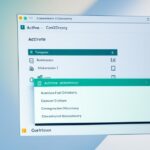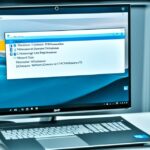To efficiently manage data in Active Directory, exporting computer information is crucial. Whether it’s for audits, making reports, or tracking your IT set-up, exporting computers from Active Greater Directory is key. It lets you collect vital information about your computers. This helps make better decisions and boost security.
Exporting Computers Using PowerShell
PowerShell is a favoured way to export computers from Active Directory. Its strong scripting lets you easily get computer data. You can use the Get-ADComputer cmdlet. It lets you change queries by name, operating system, last login, and if they’re enabled or not1. A PowerShell script lets you pull the info you want and save it as a CSV file. This is perfect for more analysis and making reports.
Key Takeaways
- Exporting computers from Active Directory is essential for effective data management.
- PowerShell provides a versatile and powerful tool for extracting computer information.
- The Get-ADComputer cmdlet in PowerShell offers various options for customizing queries.
- Exported computer information can be saved in a CSV file for further analysis.
With PowerShell, you can make exporting computers from Active Directory easier. It lets you adapt queries and save results in a CSV file. This is great for gathering and looking into computer data. It helps with finding unused computers, checking software, or keeping up with rules. PowerShell makes managing your IT environment more effective21.
Stay tuned for the next section. We will look at another way to export computers from Active Directory: Netwrix Auditor.
Exporting Computers Using PowerShell
PowerShell’s Get-ADComputer cmdlet is a potent tool for exporting computers from Active Directory. It lets administrators customize searches and save results as CSV files. This approach tailors data retrieval to specific needs.
Understanding the Get-ADComputer cmdlet’s capabilities is crucial. It offers various parameters that help administrators extract targeted data. This enhances their insight into the network infrastructure, as demonstrated in the statistics below.
| PowerShell Script Capabilities | Statistics |
|---|---|
| Searching based on specific properties | 1 |
| Utilizing the SearchBase parameter | 1 |
| Defining the SearchScope parameter | 1 |
| Applying filters to retrieve specific groups of computers | 1 |
| Analyzing statistics on specific operating systems | 13, |
| Filtering based on last logon date | 1 |
| Extracting information on active and disabled computers | 1 |
| Exporting results to CSV | 1 |
| Customizable options for exporting AD computers | 14, |
To start, combine the Get-ADComputer with the Export-CSV cmdlet. This exports specific computer data from Active Directory into a CSV file. Analysis or reporting can then be conducted on this file. System administrators can adjust the script to suit their unique needs.
Let’s say you want to find all Windows 10 Pro computers in your organization. Using a filter like “OperatingSystem -eq ‘Windows 10 Pro’,” will pinpoint these devices. This filter ability isolates computers for detailed analysis, improving network management (source).
Exporting Computers to a CSV File
Exporting computer info to a CSV file with PowerShell is easy (source). After running the script, use the Export-CSV cmdlet to create a CSV file. This file can be opened in apps like Microsoft Excel, offering a clear view of your data.
By tailoring the PowerShell script, you can select specific data to include, such as the computer’s name or IP address. This creates detailed reports and offers deep insights into your Active Directory. Such detail aids in managing your network more effectively, boosting efficiency.
Using PowerShell to export computers from Active Directory gives administrators powerful tools. With the Get-ADComputer cmdlet, you can filter, analyze, and export data on computers. This helps manage Active Directory, tracking computers by last logon, and sorting enabled or disabled statuses.
Exporting Computers with Netwrix Auditor
Netwrix Auditor is great for exporting computers from Active Directory. It makes the process easy and gives detailed reports56.
With this tool, getting computer data is simple. You can use predefined reports or search for what you need. For instance, the “Computer Accounts” report lets you filter by locations, like “Managers”7.
Exporting your report is easy. Just click “Export” and pick a format, like PDF, CSV, or Excel. This means you can save and share reports in the way that works best for you7.
Netwrix Auditor lets you customise reports too. You can choose to see only the active or inactive computers in certain areas. This makes it easier to focus on the info you need and stick to your security rules7.
All in all, Netwrix Auditor has a friendly interface, flexible export options, and detailed reports. It’s a top choice for managing and exporting computer data from Active Directory7.
FAQ
How can I export computers from Active Directory?
You can export computers from Active Directory using PowerShell or with a tool like Netwrix Auditor.
How do I export computers using PowerShell?
To export computers using PowerShell, run a script in PowerShell ISE. This script gets computer details using Get-ADComputer.
Then, it exports them to a CSV file with Export-CSV.
What information can I include when exporting computers using PowerShell?
You can tailor the PowerShell script. It can include details like the computer’s name, operating system, and IP address.
How can I export computers with Netwrix Auditor?
Netwrix Auditor makes exporting computers easy. Choose the “Computer Accounts” report under “Active Directory.”
Then view this on the software and export it. Formats include PDF and Excel.
What are the benefits of regularly exporting computer data from Active Directory?
Exporting data regularly from Active Directory keeps IT clean and secure. It enhances network security and compliance.
Source Links
- https://lazyadmin.nl/powershell/get-adcomputer/ – Get-ADComputer- How to Find & Export AD Computers PowerShell
- https://community.spiceworks.com/t/export_of_active_computers_users_and_groups_in_ad/626409 – Export of active computers, Users, and groups in AD
- https://blog.netwrix.com/2023/05/25/using-get-adcomputer-cmdlet-in-powershell/ – Get-ADComputer Cmdlet in PowerShell
- https://stackoverflow.com/questions/70602378/powershell-how-to-export-ad-pc-results-to-csv – Powershell: How to export AD PC results to CSV
- https://www.netwrix.com/how_to_export_ad_users_to_csv.html – How to Export Active Directory Users to CSV
- https://www.netwrix.com/download/QuickStart/Netwrix_Auditor_Event_Log_Export_Add-on_Quick_Start_Guide.pdf – Netwrix Auditor Event Log Export Add-on Quick-Start Guide
- https://www.netwrix.com/how_to_list_all_computers_in_ou.html – How to List All Computers in an OU


















